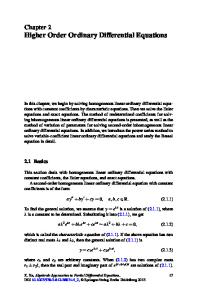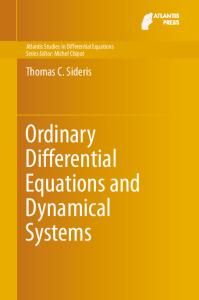Singular Ordinary Differential Operators and Pseudodifferential Equations
- PDF / 12,849,037 Bytes
- 199 Pages / 468 x 684 pts Page_size
- 32 Downloads / 506 Views
1128 Johannes Elschner
Singular Ordinary Differential Operators and Pseudodifferential Equations
Springer-Verlag Berlin Heidelberg New York Tokyo
Author
Johannes Elschner Akademie der Wissenschaften der DDR, Institut fUr Mathematik Mohrenstr. 39, 1086 Berlin, German Democratic Republic
This book is also published by Akademie-Verlag Berlin as volume 22 of the series "Mathematische Forschung".
AMS Subject Classification (1980): 35J70, 41A 15, 45E05, 45L 10,47 E05, 47G05 ISBN 3-540-15194-X Springer-Verlag Berlin Heidelberg New York Tokyo ISBN 0-387-15194-X Springer-Verlag New York Heidelberg Berlin Tokyo
© 1985 Akademie-Verlag DDR-l086 Berlin Printed in the German Democratic Republic Printing: VEB KongreB- und Werbedruck, DDR-9273 Oberlungwitz Binding: Beltz Offsetdruck, Hemsbach/Bergstr. 2146/3140-543210
To Doris
and
Ulrike
IftRODUCTION Various problems in phy8ics and engineering lead to a linear ordinary differential equation whose coefficient of the highest derivative vanishes at certain points. Such an equation is called degenerate or singular, and a zero of the leading coefficient is said to be a singular point or singularity of the corresponding differential operator. In Chapters 1 and 2 of these notes we consider linear ordinary differential operators with a singular point at the origin: A ..
xqDl +
L
ai(X)Di , D .. d/dx , qE IN.
(1)
In case of the homogeneous equation Ay .. 0 with analytic coefficients ai' the investigation of singular differential equations has a long history. In particular, starting with the works of Fuchs and Poincar6 in the second half of the last century, the asymptotic behaviour as x. 0 of solutions to such equations has been studied by many authors; see e.g. Sternberg (1), Wasow [1], Ince
In contrast to that, gen-
eral results on the solvability of the degenerate inhomogeneous equation Ay .. f have been obtained only during the last fifteen years, using the methods of linear fUnctional analysis. In order to describe such a result and the material of these notes, it
is necessary to recall some definitions. Let X and Y be linear topological spaces, and A : X Y a definition D(A)
C X.
linear operator with the domain of
If A is a continuous map of X into Y and D(A) .. X,
we shall write A L(X, Y) and AE L(X) when X .. Y. A is called normally solvable if its range im A .. A(D(A»
is closed in Y. The dimension
dim ker A of the kernel ker A .. txt: D(A) : Ax .. 0 J will be called the kernel index or nUllity of A, and the deficiency dim 'Y/im A of im A in Y will be called the deficiency index of A. If A is normally solvable and its kernel and deficiency indices are both finite, we say that A is a Fredholm operator, and its index is defined by ind A .. dim ker A dim Y/im A. Furthermore, A is called
+- (resp.
P_)operator i f it
is normally solvable and dim ker A..:; 00 (zeap, dim Y/im A.::. (0). For Fredholm and
±operators
and their basic properties, we refer to the
5
exposition in Goldberg [1],
[1J, Przeworska-Rolewicz and
Rolewioz [1J. Malgrange [1J,
Data Loading...











